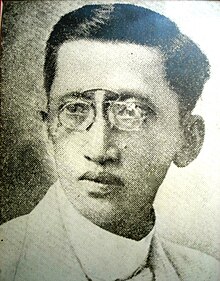Epifanio de los Santos
| Epifanio de los Santos | |
|---|---|

De los Santos graduation picture at Ateneo de Manila
|
|
| Born |
Epifanio de los Santos y Cristóbal April 7, 1871 Malabon, Manila, Captaincy General of the Philippines |
| Died | April 18, 1928 (aged 57) Manila, Philippine Islands (in office) |
| Other names | Don Pañong, G. Solon (pen name), Señor de los Santos, ED or EDS (acronym) |
| Alma mater |
University of Santo Tomas Ateneo Municipal de Manila |
| Occupation | Writer, researcher, lawyer, politician, public servant |
| Known for | The First Filipino Academician, Great among the Great Filipino Scholars, A Man of Many Talents |
Epifanio de los Santos y Cristóbal, sometimes known as Don Pañong or Don Panyong (April 7, 1871—April 18, 1928) was a noted Filipino historian,literary critic,art critic,jurist,prosecutor, antiquarian,archivist, scholar, painter, poet, musician,musicologist,philosopher,philologist,bibliographer, translator,journalist, editor, publisher,paleographer,ethnographer, biographer,researcher,civil servant, patriot and hero. He was appointed Director of the Philippine Library and Museum by Governor General Leonard Wood in 1925.
Epifanio de los Santos was born in 1871 in Malabon, Manila (now an independent city) to Escolastico de los Santos of Nueva Ecija and musician Antonina Cristóbal y Tongco. He studied at the Ateneo Municipal de Manila where he obtained a summa cum laude' of Bachelor of Arts degree. He devoted some time for painting but music became part of his daily life and was even awarded a professorship in music. He finished his law studies in University of Santo Tomas and topped the bar exams in 1898.Rafael Palma (1930) noticed that during his college years his collecting instinct was early manifested when he curiously dedicated himself gathering plants and flowers in the Nueva Ecija wherein he also sought the company and even communed with the rural communities. According to Agoncillo, "nobody suspected that he would someday become a literary man". As a young law student, his fascination in the study of Spanish literature was through readings of Juan Valera's novel entitled "Pepita Jimenez" and most of all his available works. Eventually, he formed a delightful and lasting friendship with this author which he met in Spain. His home in Intramuros became the meeting place of literary cliques composed of Cecilio Apóstol (Catulo), Fernando María Guerrero (Fulvio Gil), José Palma, Rafael Palma, Jaime C. de Veyra, Macario Pineda, Mariano V. del Rosario, Salvador V. del Rosario, Ysidro Paredes, Macario Adriatico, Jose Clemente Zulueta and Jose G. Abreu. He made a beautiful oil portrait of Rosa Sevilla and composed a melody dedicated for her.
...
Wikipedia
